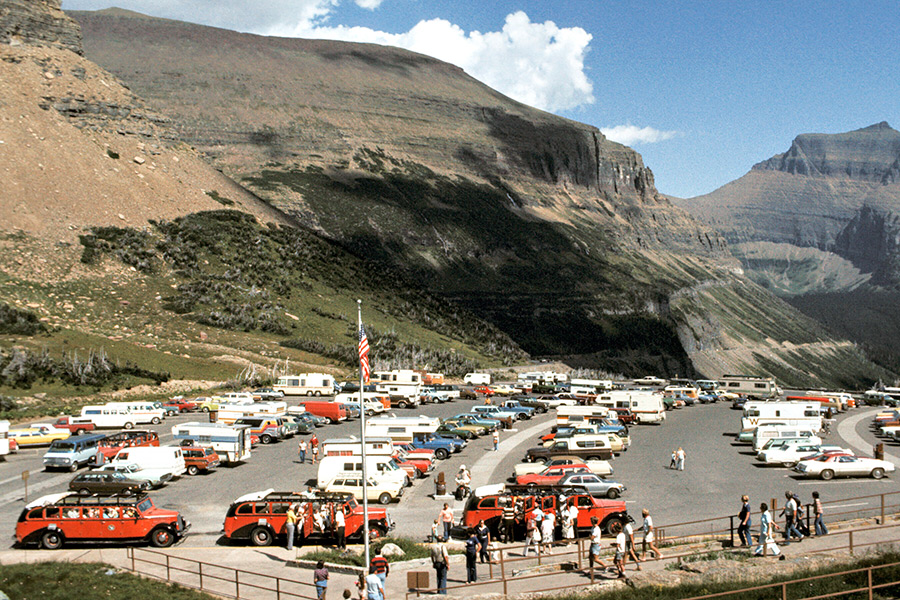In 1936, Franklin D. Roosevelt was reelected for a second term as president, Jesse Owens won gold in the 100-meter dash at the Berlin Olympics and American newspapers published the first comic strip to feature a superhero wearing a skin-tight costume.
Meanwhile, in Northwest Montana, more than 210,000 people visited Glacier National Park and a new fleet of tour buses hit the road.
Eight decades later, Roosevelt and Owens have long secured their spots in the pages of history, superheroes wearing spandex are common and Glacier annually welcomes 10 times the visitors it did in 1936. But 80 years later, the buses remain, climbing Going-to-the-Sun Road every summer and giving visitors from around the park tours of the scenic park.
The first batch of Glacier Park’s iconic Red Buses arrived from the White Motor Company of Cleveland, Ohio in 1936 and replaced an older fleet of touring buses that had been in the park since the 1910s. The new buses were designated as Model 706.
Prior to the 1930s, there was no standard touring bus in America’s national parks. In 1935, four automotive companies created their own version of the ideal touring vehicle and they were brought to Yosemite National Park for a road test. Loaded with sandbags to simulate a busload of passengers, White’s Model 706 outperformed the rest and soon became the standard touring vehicle across the West. Besides being powerful enough to make it over the roller coaster routes of rugged national parks, the 706s also featured stylish lines that were the brainchild of industrial designer Alexis de Sakhnoffsky. Prior to designing the tour buses, the Russian immigrant made a name for himself designing vehicles for the Packard Motor Car Company.
Over the next few years, more than 500 touring buses were built for use in national parks across the country. More than 100 were sent to Yellowstone National Park and 35 were sold to the Glacier Park Transportation, Co. In 1936, the first 18 buses, Nos. 78 through 95, arrived in the park.
Since then, the buses have provided tours in and out of the park, mostly during the busy summer season. Of the 35 built for the park, 33 are still in use. The National Park Service has retained No. 78, the first built for Glacier, as a museum piece and another was destroyed in a wreck.
Through the years, most of the national park’s 706 touring buses were wrecked or sold off and Glacier’s is the only remaining fleet. The current operator of the “Reds,” Xanterra Parks and Resorts, frequently touts the fact that Glacier’s buses are the oldest intact fleet of passenger vehicles in the world.
The beloved buses were almost taken off the road for good in the 1990s. In July 1999, after dropping off a load of passengers at Lake McDonald Lodge, the front axle of a Red Bus detached from its frame. An emergency inspection of the entire fleet revealed that almost all of the buses had cracks in their chassis and they were immediately sidelined. A subsequent inspection convinced one Glacier Park, Inc. official that the buses were “beyond repair.”
Later that year, the Ford Motor Company offered to rebuild the entire fleet for nearly $7 million. The rebuilt buses returned to the road in 2002.
Today, when the buses are not traveling the park, they are stored at a state-of-the-art facility built in 2015 by Xanterra near Columbia Falls.
“The buses work hard three months of the year going up and down the mountain and then we work on them the other nine months of the year,” Transportation Director Dave Eglsaer said, adding that each bus logs thousands of miles per season and annually hauls 50,000 passengers.
“These buses are going to be moving a lot of people this summer,” Eglsaer said.
Fifteen years and nearly 150,000 miles after their last overhaul, Xanterra is preparing to refurbish the fleet again. Eglsaer said the company plans on refurbishing one this coming winter and then four or five each year after. The rebuild will feature new engines and chassis and is expected to cost upwards of $8 million.
Eglsaer said the rebuild would ensure that the fleet is still climbing Glacier’s iconic Sun Road eight decades from now.
For more information, visit www.glaciernationalparklodges.com.
